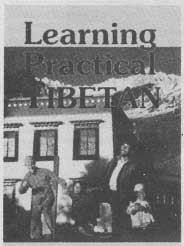| The following article is from the Winter, 1998 issue of the Snow Lion Newsletter and is for historical reference only. You can see this in context of the original newsletter here. |
by Andrew Bloomfield & Yanki Tshering 175 pp., 6 x 9 #LEPRTI $16.95 Available Feb.

Learning Practical Tibetan is a revised version of the Tibetan Phrasebook, which was published in 1987 by Snow Lion Publications. Many students of Tibetan language have expressed to Snow Lion that this book is a wonderful language tool much more than a phrasebookas it has helped them understand the basics of the spoken Tibetan language.
Based upon numersou requests, Snow Lion has expanded the Tibetan Phrasebook into a larger format which presents phrases, dialogues, and vocabulary in Tibetan script, in phonetics, and on cassette tapes.
This package is ideally suited for:
1. the English-speaking student who has already been studying Tibetan language who will be working primarily with the tapes and the Tibetan script.
2. the beginning student of modern spoken Tibetan who is not interested so much in learning the written language but who would like to improve their communication skills in reliance upon the tapes and the phonetic system.
3. native Tibetan speakers wishing to learn English.
4. travelers.
Learning Practical Tibetan begins by introducing both a phonetic system and a simple yet complete grammar. In addition to containing phrases and dialogues, each chapter is preceded by useful information, vocabulary, and some pointers about Tibetan customs and etiquette. The appendices include these helpful sections: Numbers, Dates, Days and Time, Dates of Festivals, Religious and Monastic Vocabulary and a General Vocabulary.
The clear and simple form of romanization, along with the cassette tapes, ensures that the student will be understood when speaking.
Andrew Bloomfield graduated from the University of Arizona in Oriental Studies and spent several years living and studying with Tibetans in Nepal. He currently lives in Los Angeles.
Yanki fshering studied modern Tibetan at Tribhuvan University in Kathmandu, Nepal, and taught at the Experiment in International Living. She compled her master's degree at Columbia University.
To the right is a sample of Tibetan greetings from the book.
Tibetan Greetings
The following are common phrases used daily among Tibetans. Honorifics are found in phrases of greeting more than anywhere else. Don't worry if you can't immediately catch on to their usesince they are common,, you'll have many opportunities to practice.
Hello.
Tah-shi de-leh.

ξ
How are you?
Keh-rahng ku-su de-bo yin-peh?
(you) (body) (well) (is it)

ξ
I'm fine.
La yin. Ngah sug-po de-bo yin.
(yes) (I) (body) (well) (is)

Note the honorific word for body (ku-su). The non-honorific form is used when speaking about oneself, thus ku-su changes to sug-po in the sentence I'm fine.
ξ
Please sit down.
Shoo-ro-nahng. (Shoo is the honorific form of deh: sit.)
(sit) (please)

Another way of greeting is simply to ask someone where they are going:
ξ
Where are you going?
Keh-rahng kah-bah phe-geh?
(you) (where) (are going)

Phe is the honorific form of the verb go (dro). The use of phe-geh is the shortened version of the question form as mentioned the grammar section.
ξ
Goodbye. Kah-leh phe.
(carefully) (go)

(said to the person leaving, or in the case that both of you are leaving)
Goodbye.
Kah-leh shoo.
(carefully) (stay)

(said to the person remaining behind)
ξ
See you later.
Jeh yong.
(meet) (come)

ξ
See you tonight.
To-gong jeh yong.
(tonight) (meet) (come)

ξ
See you tomorrow.
Sahng-nyi jeh yong.
(tomorrow) (meet) (come)

ξ
Goodnight.
Sim-jah nahng-go.
Phrases like I'm sorry {gong-dah), and thank you (thuchi che), are not commonly spoken. They should not be used as freely as they are here in the West, but should be reserved for extreme situations. ä_æ

